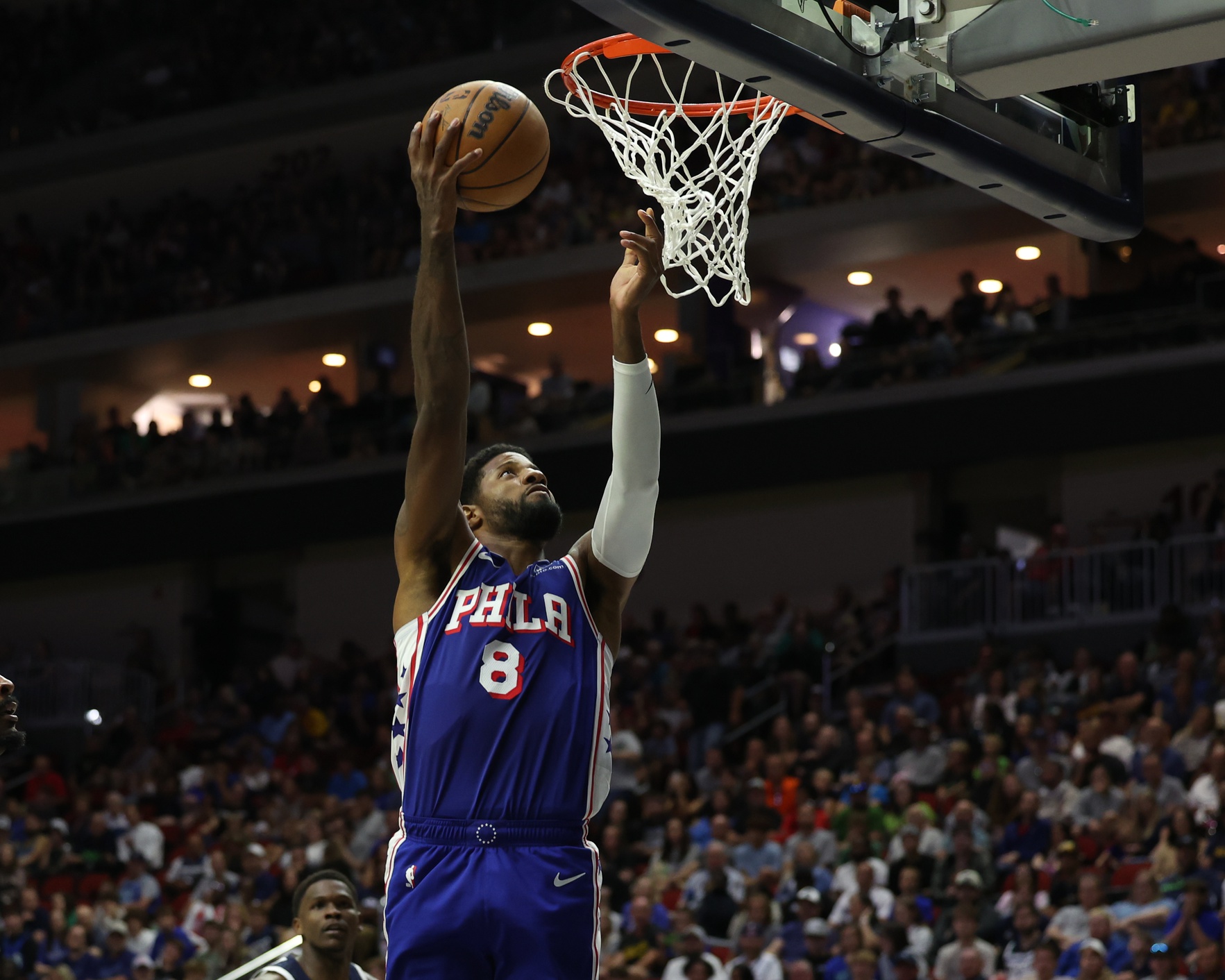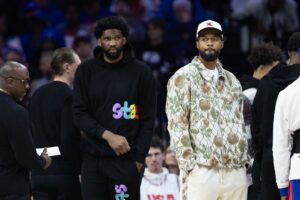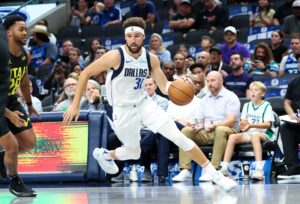The 2024 NBA offseason was marked by major trades and free agency moves, reshaping several franchises. These shifts were heavily influenced by the league’s new Collective Bargaining Agreement (CBA). Its second apron rule limits team spending and forces more creative roster decisions. The second apron played a crucial role in some of the biggest moves of the 2024 free agency.
NBA Business: How Second Apron Shaped The Biggest NBA Free Agency Moves In 2024
Paul George to Philadelphia
Philadelphia made a significant gamble, using its hoarded cap space to secure Paul George from the Los Angeles Clippers. The 76ers had Joel Embiid and Tyrese Maxey already in place. They needed another star to form a formidable trio. George’s move became possible because the Clippers, constrained by the second apron’s penalties, balked at offering him a no-trade clause alongside a sizable contract extension. George, looking for more security, found a willing partner in Daryl Morey. He quickly snatched up the All-Star forward to form a new Big 3. This transaction illustrates how the second apron can force teams to prioritize. In this case, Los Angeles chose to move on from George to avoid further luxury tax penalties.
Mikal Bridges and Karl-Anthony Towns to New York
The New York Knicks made headlines with two blockbuster moves: trading for Mikal Bridges and Karl-Anthony Towns. Leon Rose, Knicks president, doubled down on the team’s successful 50-win season. Bridges, a two-way wing, was acquired at the cost of five first-round picks. Towns was brought in to replace Julius Randle. Under the new CBA, teams hitting the second apron face harsh penalties. This makes it difficult to keep star-studded rosters intact without sacrificing depth. New York capitalized on this, taking advantage of Minnesota’s and Brooklyn’s willingness to move key players to avoid second apron penalties and rebuild respectively. The deals showcased how the new financial restrictions allow teams like the Knicks to benefit from franchises needing to make hard choices about who to keep.
Klay Thompson to Dallas
Dallas addressed its need for more shooting by acquiring Klay Thompson from Golden State. Thompson’s frustration with the Warriors — who were reluctant to offer him a high-value deal under the second apron constraints — opened the door for his departure. The second apron played a critical role in this scenario. Golden State could no longer afford to maintain its expensive core without suffering heavy financial penalties. The Mavericks, on the other hand, had room to add Thompson. They did so to boost their offense alongside Luka Dončić and Kyrie Irving. This move is a clear example of how the second apron forces even successful franchises to part ways with longtime stars.
DeMar DeRozan to Sacramento
Sacramento capitalized on the second apron dynamics by acquiring DeMar DeRozan in a sign-and-trade with Chicago. As teams work to balance their rosters and avoid excess spending, the Kings emerged as a suitor for DeRozan, offering him a key role in a rising team. For Chicago, the luxury tax likely influenced their decision to part ways with the veteran forward. It was to avoid financial consequences for a team that wasn’t competitive. It also finally broke up their never-healthy core. DeRozan’s fit in Sacramento — alongside Domantas Sabonis and De’Aaron Fox — strengthens the Kings’ chances of returning to the playoffs. This shows how teams can benefit from other franchises’ cap limitations.
Alex Caruso and Isaiah Hartenstein to Oklahoma City
Oklahoma City are a rising team in the Western Conference. They made some of the best offseason moves by adding Alex Caruso and Isaiah Hartenstein. Both players fill critical needs for the Thunder, bolstering their defense and frontcourt. The second apron’s impact is evident here, as a team like the Bulls, facing luxury tax concerns, let go of akey contributor. Oklahoma City, with a more manageable cap situation, swooped in to add these valuable pieces to a roster already featuring Shai Gilgeous-Alexander and Chet Holmgren.
Kentavious Caldwell-Pope Swaps the Nuggets for the Orlando Magic
The Denver Nuggets decided to let Kentavious Caldwell-Pope explore free agency due to financial concerns tied to the NBA’s second apron restrictions. While they valued his defensive contributions, they were cautious about exceeding the luxury tax. The Orlando Magic capitalized, signing Caldwell-Pope to a three-year, $66 million contract, allowing him to become their starting shooting guard. With this move, Denver prioritized staying flexible under the new CBA while promoting younger talents like Christian Braun.
Isaac Okoro’s Prolonged Extension with the Cavaliers
Isaac Okoro’s restricted free agency with the Cleveland Cavaliers extended for over two months, concluding with a three-year, $38 million deal on September 17, 2024. Negotiations took time due to the gap between Okoro’s asking price—reportedly $12-15 million annually—and Cleveland’s initial willingness to offer $8-10 million per year. Ultimately, both sides compromised, with Okoro securing $33 million in guaranteed money, a figure higher than the Cavaliers had hoped to pay but lower than his original demands.
Okoro’s defensive prowess, particularly his ability to guard multiple positions, played a key role in the Cavs’ decision to retain him. His offensive game has improved, with a career-best 39.1% from three-point range during the 2023-24 season, but his overall shooting consistency remains a question mark. The Nets and Hornets showed interest in Okoro before his deal was finalized. However, Cleveland chose to keep him as a key defensive piece for their future.
Veteran Minimums to Mid-Tier Players
The 2024 free agency was heavily impacted by the new CBA’s second apron restrictions, which limited how teams could use their cap space. Many teams prioritized their star players and focused on affordable role players. This led mid-tier talents in their mid-20s to sign veteran minimum deals. This adjustment period in the market typically takes two or three offseasons for teams to fully understand the implications of a new CBA. 2024 was the expected first year with tepid activity.
Tyus Jones had a productive season with the Wizards. Gary Trent Jr., was a reliable shooter for the Raptors. They both signed one-year veteran minimum deals despite being in their prime. Jones joined the Phoenix Suns on a $3.3 million deal. Trent Jr. moved to the Milwaukee Bucks. Both players likely took short-term deals in anticipation of next offseason. More teams might have cap flexibility and willingness to offer larger contracts. Teams such as the Suns and Bucks, operating under second apron constraints, were able to capitalize on this adjustment year in the market. They added key contributors at a low cost .
The Impact of the Second Apron
Under the new CBA, the second apron sets a clear dividing line for teams. Those that exceed the threshold face severe limitations on their ability to add players via exceptions, sign-and-trades, and buyout market signings. As a result, many franchises are forced to move high-salaried players to maintain flexibility. This has created a more dynamic trade market. Teams with cap space or manageable rosters, like Philadelphia, New York, and Oklahoma City, can capitalize on the financial restrictions placed on teams like Golden State, the Clippers, and Minnesota.
By compelling teams to make difficult choices about which stars to keep and which to let go, the second apron has reshaped how organizations approach team building. The 2024 free agency demonstrated how the second apron accelerated major trades and redefined the landscape of the NBA.
The NBA likely designed the second apron to curb excessive spending. However, it has also created new opportunities for teams willing to gamble and reshape their rosters. Philadelphia’s bold acquisition of George and New York’s moves for Bridges and Towns are examples of this. Ultimately, the second apron forced teams to get creative. The result has been one of the more exciting offseasons in recent memory.






